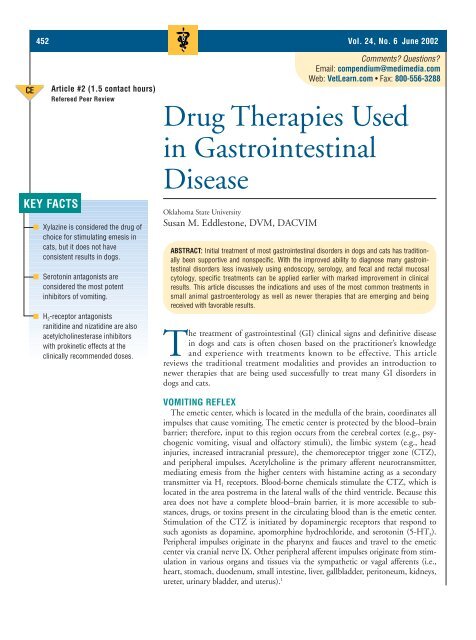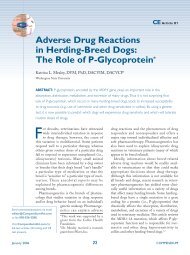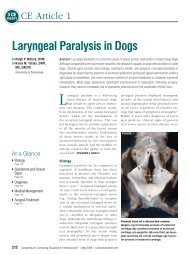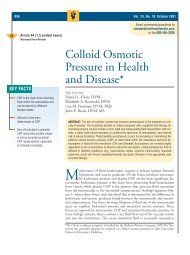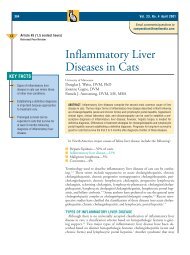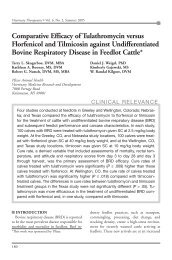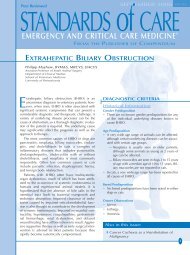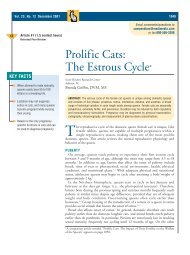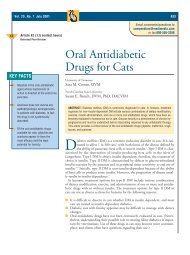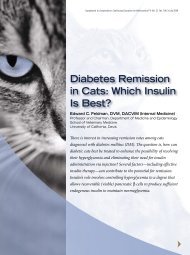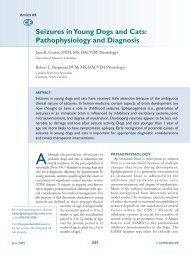Create successful ePaper yourself
Turn your PDF publications into a flip-book with our unique Google optimized e-Paper software.
CE<br />
452 V<br />
Vol. 24, No. 6 June 2002<br />
Article <strong>#2</strong> (1.5 contact hours)<br />
Refereed Peer Review<br />
KEY FACTS<br />
■ Xylazine is considered the drug of<br />
choi<strong>ce</strong> for stimulating emesis in<br />
cats, but it does not have<br />
consistent results in dogs.<br />
■ Serotonin antagonists are<br />
considered the most potent<br />
inhibitors of vomiting.<br />
■ H 2-re<strong>ce</strong>ptor antagonists<br />
ranitidine and nizatidine are also<br />
a<strong>ce</strong>tylcholinesterase inhibitors<br />
with prokinetic effects at the<br />
clinically re<strong>com</strong>mended doses.<br />
Comments? Questions?<br />
Email: <strong>com</strong>pendium@medimedia.<strong>com</strong><br />
Web: <strong>VetLearn</strong>.<strong>com</strong> • Fax: 800-556-3288<br />
Drug Therapies Used<br />
in Gastroin<strong>test</strong>inal<br />
Disease<br />
Oklahoma State University<br />
Susan M. Eddlestone, DVM, DACVIM<br />
ABSTRACT: Initial treatment of most gastroin<strong>test</strong>inal disorders in dogs and cats has traditionally<br />
been supportive and nonspecific. With the improved ability to diagnose many gastroin<strong>test</strong>inal<br />
disorders less invasively using endoscopy, serology, and fecal and rectal mucosal<br />
cytology, specific treatments can be applied earlier with marked improvement in clinical<br />
results. This article discusses the indications and uses of the most <strong>com</strong>mon treatments in<br />
small animal gastroenterology as well as newer therapies that are emerging and being<br />
re<strong>ce</strong>ived with favorable results.<br />
The treatment of gastroin<strong>test</strong>inal (GI) clinical signs and definitive disease<br />
in dogs and cats is often chosen based on the practitioner’s knowledge<br />
and experien<strong>ce</strong> with treatments known to be effective. This article<br />
reviews the traditional treatment modalities and provides an introduction to<br />
newer therapies that are being used suc<strong>ce</strong>ssfully to treat many GI disorders in<br />
dogs and cats.<br />
VOMITING REFLEX<br />
The emetic <strong>ce</strong>nter, which is located in the medulla of the brain, coordinates all<br />
impulses that cause vomiting. The emetic <strong>ce</strong>nter is protected by the blood–brain<br />
barrier; therefore, input to this region occurs from the <strong>ce</strong>rebral cortex (e.g., psychogenic<br />
vomiting, visual and olfactory stimuli), the limbic system (e.g., head<br />
injuries, increased intracranial pressure), the chemore<strong>ce</strong>ptor trigger zone (CTZ),<br />
and peripheral impulses. A<strong>ce</strong>tylcholine is the primary afferent neurotransmitter,<br />
mediating emesis from the higher <strong>ce</strong>nters with histamine acting as a secondary<br />
transmitter via H 1 re<strong>ce</strong>ptors. Blood-borne chemicals stimulate the CTZ, which is<br />
located in the area postrema in the lateral walls of the third ventricle. Because this<br />
area does not have a <strong>com</strong>plete blood–brain barrier, it is more ac<strong>ce</strong>ssible to substan<strong>ce</strong>s,<br />
drugs, or toxins present in the circulating blood than is the emetic <strong>ce</strong>nter.<br />
Stimulation of the CTZ is initiated by dopaminergic re<strong>ce</strong>ptors that respond to<br />
such agonists as dopamine, apomorphine hydrochloride, and serotonin (5-HT 3).<br />
Peripheral impulses originate in the pharynx and fau<strong>ce</strong>s and travel to the emetic<br />
<strong>ce</strong>nter via cranial nerve IX. Other peripheral afferent impulses originate from stimulation<br />
in various organs and tissues via the sympathetic or vagal afferents (i.e.,<br />
heart, stomach, duodenum, small in<strong>test</strong>ine, liver, gallbladder, peritoneum, kidneys,<br />
ureter, urinary bladder, and uterus). 1
Compendium June 2002 Drug Therapy/GI Disease 453<br />
Table 1. Emetic Drugs<br />
Drug Dose Comment<br />
3% Hydrogen peroxide Dogs and cats: 5–10 ml PO, one to two<br />
doses as needed<br />
Fatal aspiration of foam is possible in cats<br />
Ipecac syrup Dogs: 1–2.5 ml/kg PO; cats: 1–3.3 Not to ex<strong>ce</strong>ed 15 ml/dog; dogs and<br />
ml/kg PO (may cause toxicity and death) cats: dose may be repeated on<strong>ce</strong> but<br />
product must be removed via gastric<br />
lavage if vomiting does not occur<br />
Apomorphine hydrochloride Dogs: 0.04 mg/kg IV, 0.08–0.1 mg/kg<br />
IM or SC, or 0.25 mg (conjunctival sac)<br />
Not re<strong>com</strong>mended for use in cats<br />
Xylazine Cats: 0.44 mg/kg IM Not effective in dogs; emesis in cats<br />
should occur within 15 min;<br />
sedation lasts 1–2 hr<br />
EMETICS<br />
Emetics are used to indu<strong>ce</strong> vomiting in dogs and cats<br />
for early treatment of ingestion of noncorrosive toxins.<br />
Within the first 30 minutes to 1 hour after toxic ingestion,<br />
emetics can help eliminate the toxin from the<br />
stomach before they are absorbed in the small in<strong>test</strong>ine.<br />
Emesis should never be indu<strong>ce</strong>d in patients that are<br />
unconscious, experiencing a seizure, or having respiratory<br />
difficulty. Reflux emesis can be indu<strong>ce</strong>d by instilling<br />
warm water (5 to 10 ml/kg) into the stomach via a<br />
stomach tube. This will dilute the toxin and initiate the<br />
vomiting reflex by stimulating peripheral re<strong>ce</strong>ptors in<br />
the stomach that respond to distention.<br />
Gastric mucosa irritants can also indu<strong>ce</strong> the vomiting<br />
reflex peripherally. Orally administered hypertonic<br />
saline solution or table salt, 3% hydrogen peroxide<br />
solution, or ipecac syrup or powder (i.e., emetine) can<br />
be effective and administered at home prior to an emergency<br />
visit (Table 1). Ipecac in cats can be toxic, particularly<br />
with the administration of multiple doses that<br />
can be absorbed systemically. Hydrogen peroxide can<br />
foam and cause fatal aspiration in cats; therefore, it<br />
should be used with caution in this species. 1<br />
Centrally acting drugs are more potent stimulants of<br />
the vomiting reflex. Apomorphine hydrochloride, an opioid<br />
and synthetic derivative of morphine, stimulates the<br />
CTZ by acting on dopamine re<strong>ce</strong>ptors. 1 It is available as a<br />
powder inside a capsule and can be mixed in sterile water<br />
and given subcutaneously. The tablet form, which is more<br />
expensive, can be used in the conjunctival sac for quick<br />
absorption. Oral administration usually requires a much<br />
higher dose because of decreased oral bioavailability. 1<br />
Likewise, giving subsequent doses does not improve the<br />
vomiting effect but may actually suppress the emetic <strong>ce</strong>nter.<br />
Although considered only a mild CNS depressant,<br />
apomorphine hydrochloride should not be used in animals<br />
with depressed CNS conditions. Apomorphine<br />
hydrochloride is not re<strong>com</strong>mended for use in cats because<br />
they need a higher dose to indu<strong>ce</strong> vomiting, and this can<br />
cause excitement and hyperactivity of the CNS. 1<br />
Xylazine, an α 2-agonist, is the drug of choi<strong>ce</strong> to stimulate<br />
emesis in cats. 1 Although it is used more <strong>com</strong>monly<br />
for its sedation/analgesic properties, it can be<br />
used at a lower dose to indu<strong>ce</strong> vomiting in cats. In dogs,<br />
xylazine is not as consistent at inducing emesis. There<br />
are no reports on the use of medetomidine, a drug with<br />
similar actions, to indu<strong>ce</strong> emesis in either species.<br />
ANTIEMETICS<br />
Vomiting occurs in dogs and cats as a result of many<br />
GI and non-GI disorders. Suppression of vomiting is<br />
indicated when the underlying cause is known and<br />
serves to prevent further metabolic alterations caused<br />
by the loss of fluid, gastric acids, and electrolytes.<br />
Although treatment of the underlying cause is always<br />
the primary objective, the use of antiemetics for the<br />
interim to prevent further debilitation is beneficial.<br />
Suppressing vomition is contraindicated in patients<br />
with pyloric or in<strong>test</strong>inal obstruction.<br />
Dopamine Antagonists<br />
Metoclopramide, a dopamine antagonist, blocks<br />
dopamine re<strong>ce</strong>ptors at the CTZ 2 (Table 2). It is suspected<br />
that at higher doses, antagonism is at the 5-HT 3 re<strong>ce</strong>ptors.<br />
This agent is reported to be 20 times more potent than<br />
phenothiazines, although this differen<strong>ce</strong> in efficacy has not<br />
been documented in dogs and cats. 3 Metoclopramide also<br />
has prokinetic effects, which may help minimize vomiting<br />
by increasing upper GI motility, increasing lower<br />
esophageal sphincter tone, decreasing pyloric sphincter<br />
tone, and promoting antegrade contraction of the gastric<br />
antrum. A side effect is CNS stimulation that presents as<br />
irritability or nervousness, particularly in cats. The antidote<br />
for this side effect is diphenhydramine hydrochloride
454 Small Animal/Exotics Compendium June 2002<br />
Table 2. Antiemetic Drugs<br />
Drug Dose Comment<br />
Metoclopramide Dogs and cats: 0.1–0.5 mg/kg PO or Use lower doses with renal failure;<br />
SC q8h, 0.02 mg/kg IV q1h, or 1–2 <strong>com</strong>mon side effects are anxiety and<br />
mg/kg/day IV by CRI restlessness in dogs and cats<br />
Domperidone Dogs and cats: 0.1–0.5 mg/kg IM or<br />
IV q12h or 2–5 mg/kg PO q12h<br />
Not available in the United States<br />
Ondansetron Dogs and cats: 0.1–0.2 mg/kg SC q8h, No side effects are known; further<br />
0.1–1.0 mg/kg q12–24h PO, 0.5 mg/kg<br />
IV load, or 0.5 mg/kg IV infusion q1h<br />
investigation is needed in dogs and cats<br />
Dolasetron Dogs and cats: to prevent nausea or Can be <strong>com</strong>bined with metoclopramide<br />
vomiting—0.6 mg/kg/day IV or PO; for optimal prevention of chemotherapyvomiting—1<br />
mg/kg/day IV or PO indu<strong>ce</strong>d nausea and vomiting in dogs<br />
and cats<br />
Chlorpromazine Dogs: 0.2–0.4 mg/kg IM or SC q6–8h,<br />
3.3 mg/kg PO q6–8h; cats: 0.5 mg/kg<br />
IM or SC q6–8h, 2.0–4.0 mg/kg/day PO<br />
May cause sedation<br />
Prochlorperazine Dogs: 0.25–0.5 mg/kg IM q8–12h<br />
or 1 mg/kg PO q12h; cats: 0.13 mg/kg<br />
IM q12h or 0.5 mg/kg PO q12h with food<br />
May cause sedation in dogs and cats<br />
Trifluoperazine Dogs and cats: 0.03 mg/kg IM q12h May cause sedation in dogs and cats<br />
Cyclizine hydrochloride Dogs and cats: 4 mg/kg IM q8h For vestibular disease–indu<strong>ce</strong>d emesis<br />
Meclizine hydrochloride Dogs 10 kg: 2–6 mg/kg/day PO;<br />
cats: 4 mg/kg/day PO<br />
For vestibular disease–indu<strong>ce</strong>d emesis<br />
Diphenhydramine hydrochloride Dogs and cats: 2–5 mg/kg PO q6–8h, For vestibular disease–indu<strong>ce</strong>d emesis<br />
2 mg/kg IM or IV (slowly) q12h<br />
CRI = constant-rate infusion.<br />
(1 mg/kg IV) in dogs and cats. 4 Contraindications are GI<br />
hemorrhage and obstruction. Other dopamine antagonists<br />
that have been available but less <strong>com</strong>monly used are domperidone<br />
and the butyrophenone derivatives haloperidol<br />
and droperidol. Domperidone, which is similar to metoclopramide<br />
in activity, is currently not available in the<br />
United States for use in dogs and cats. The butyrophenones<br />
cause potent tranquilizer side effects and seizures in<br />
preepileptic patients.<br />
Serotonin Antagonists<br />
Serotonin antagonists, also known as 5-HT 3 antagonists,<br />
are a relatively new class of antiemetic drug that<br />
blocks stimulation at the CTZ and in the in<strong>test</strong>ine to<br />
prevent vomiting. 5 The neurotransmitter serotonin acts<br />
by increasing the secretion of a<strong>ce</strong>tylcholine at distal<br />
ganglia, thereby stimulating the CTZ to indu<strong>ce</strong> vomiting.<br />
Serotonin antagonists block this mechanism and<br />
are considered the most potent inhibitors of vomiting.<br />
They are particularly useful for preventing vomiting<br />
indu<strong>ce</strong>d by chemotherapy, parvovirus, and causes that<br />
are resistant to other therapies. 5-HT 3 antagonists that<br />
are available include ondansetron, tropisetron,<br />
granisetron, azesetron, and dolasetron. Ondansetron<br />
and dolasetron have been reported to be very effective<br />
in both dogs and cats 6 ; however, the high cost of these<br />
drugs limits their use to chemotherapy patients or<br />
patients unresponsive to other medications. Side effects<br />
have not been reported in dogs and cats; however, indepth<br />
study of these drugs in <strong>com</strong>panion animals have<br />
not been published.<br />
Phenothiazines<br />
Phenothiazines control vomiting by inhibiting the<br />
CTZ as a result of their antidopaminergic and antihistaminergic<br />
effects. 2 Phenothiazine derivatives used as<br />
antiemetics in small animals include chlorpromazine,<br />
prochlorperazine, triflupromazine, perphenazine, trifluoperazine,<br />
and mepazine. Side effects associated with phenothiazines<br />
are sedation, hypotension caused by peripheral<br />
α blockade, and seizures in preepileptic patients.<br />
Glucocorticoids<br />
Glucocorticoids are used in human medicine to con-
Compendium June 2002 Drug Therapy/GI Disease 455<br />
Table 3. Antisecretory Drugs<br />
Drug Dose Comment<br />
Cimetidine Dogs and cats: 5–10 mg/kg PO q6–8h Give IV dose slowly over 30–40 min<br />
or 10 mg/kg IV q6h in dogs and cats; cytochrome P450<br />
microsomal enzyme inhibitor<br />
Ranitidine Dogs and cats: 0.5–2 mg/kg PO,<br />
IV, IM, or SC q8–12h<br />
No serious side effects reported<br />
Famotidine Dogs and cats: 0.5–1.0 mg/kg PO<br />
or IV q12–24h<br />
No serious side effects reported<br />
Nizatidine Dogs: 5 mg/kg/day PO No serious side effects reported<br />
Omeprazole Dogs: 0.5–1.0 mg/kg/day PO Achlorhydria, diarrhea, and transient<br />
fluctuations in liver enzymes reported<br />
trol vomiting, although the exact mechanism of action<br />
is not understood. These agents may have a synergistic<br />
effect when used with other antiemetics, such as metoclopramide,<br />
particularly when used in chemotherapy<br />
patients. Because of the side effects of gastric, duodenal,<br />
and colonic ul<strong>ce</strong>ration, the use of glucocorticoids<br />
for vomiting is not re<strong>com</strong>mended.<br />
Barbiturates and Benzodiazepines<br />
Barbiturates (e.g., phenobarbital) and benzodiazepines<br />
(e.g., diazepam) are sedatives that are used to control<br />
psychogenic and behavioral vomiting by acting on the<br />
higher <strong>ce</strong>nters of the brain. This type of vomiting, however,<br />
is not well documented in veterinary medicine.<br />
Anticholinergics<br />
Anticholinergics (e.g., atropine) are <strong>ce</strong>ntrally acting<br />
antiemetics that block cholinergic transmission as well as<br />
muscarinic re<strong>ce</strong>ptors in the emetic <strong>ce</strong>nter. Many anticholinergics<br />
(e.g., glycopyrrolate, propantheline, meth-
456 Small Animal/Exotics Compendium June 2002<br />
Table 4. Cytoprotective Drugs and Antacids<br />
Drug Dose Comment<br />
Aluminum magnesium hydroxide Dogs and cats: 2–10 ml PO q2–4h Preferred <strong>com</strong>bination to avoid<br />
side effects<br />
Aluminum carbonate gel Dogs and cats: 10–30 mg/kg PO Can cause diarrhea, nausea, GI upset,<br />
q8h with meals constipation, and hypophosphatemia<br />
Aluminum hydroxide Dogs and cats: 30–90 mg/kg PO Binds bile salts and phosphorus;<br />
q8–24h with meals inactivates pepsin; can cause<br />
constipation<br />
Magnesium hydroxide Dogs: 5–30 ml PO q8–24h; Can cause diarrhea; avoid<br />
cats: 5–10 ml PO q8–24h magnesium-based products in<br />
patients with renal failure<br />
Calcium carbonate Dogs: 50–75 mg/kg divided daily Can cause metabolic alkalosis,<br />
q8–12h PO hypercal<strong>ce</strong>mia, calciuria,<br />
hypophosphatemia, and constipation<br />
Misoprostol Dogs and cats: 2–5 µg/kg PO q6–8h Prevents NSAID-indu<strong>ce</strong>d gastric ul<strong>ce</strong>rs<br />
Sucralfate Dogs 15 kg: 1-g tablet q6–8h; before or after other drugs (may bind<br />
cats: 1 /4 - to 1 /2-g tablet q8–12h with other medications if administered<br />
together)<br />
scopolamine [not re<strong>com</strong>mended for use in cats], and isopropamide)<br />
do not cross the blood–brain barrier; therefore,<br />
they act peripherally. Peripheral actions that prevent<br />
vomiting are due to inhibition of afferent vagal stimulation,<br />
relaxation of smooth muscle, and inhibition of GI<br />
secretions. Unfortunately, the limiting effect is that they<br />
promote delayed gastric emptying and decreased in<strong>test</strong>inal<br />
motility, causing GI overdistention, which may in<br />
itself cause vomiting. They also inhibit the actions of<br />
such drugs as metoclopramide, cisapride, and opioids<br />
that are dependent on cholinergic activity in ganglia or<br />
smooth muscle. Because this inhibition limits their usefulness,<br />
anticholinergics are not usually re<strong>com</strong>mended. 1<br />
Antihistamines<br />
Antihistamines are used to control vomiting caused by<br />
motion sickness or inner-ear disease, which is mediated<br />
by the vestibular apparatus. Cyclizine hydrochloride,<br />
meclizine hydrochloride, or diphenhydramine hydrochloride<br />
may control vomiting for several hours. 2 Side effects<br />
of antihistamines include drowsiness and dry mouth.<br />
GASTRIC ANTISECRETORY DRUGS<br />
Gastric antisecretory drugs are most <strong>com</strong>monly used<br />
to treat gastric inflammation and ul<strong>ce</strong>ration (Table 3).<br />
Gastric ul<strong>ce</strong>ration caused by drugs, toxins, trauma,<br />
immune-mediated disease, or neoplasia may be treated<br />
by reducing the acidity of gastric secretions. Esophagitis<br />
caused by foreign bodies, ingestion of caustic substan<strong>ce</strong>s,<br />
gastric reflux during anesthesia, and chronic<br />
vomiting are also treated by reducing gastric acidity and<br />
reflux of gastric fluid.<br />
H2-Re<strong>ce</strong>ptor Antagonists<br />
H2-re<strong>ce</strong>ptor antagonists (H2 blockers), which are relatively<br />
inexpensive, are the most widely available drugs<br />
that redu<strong>ce</strong> hydrogen ion content of gastric secretions<br />
and the amount of pepsin indu<strong>ce</strong>d by other secretory<br />
enzymes. In addition, these drugs, particularly the<br />
newer ones (e.g., ranitidine, nizatidine), may also promote<br />
gastric prokinetic activity due to anticholinesterase<br />
properties. The potency and duration of action<br />
of H2 blockers are rated as follows:<br />
Famotidine > ranitidine > cimetidine2 Gastric motility potency studied in guinea pig muscle is<br />
rated as follows:<br />
Nizatidine = ranitidine > cimetidine > famotidine7 Cimetidine inhibits the cytochrome P450 microsomal<br />
enzyme system in the liver and thus impairs the metabolism<br />
of other drugs and should be avoided in animals with<br />
liver disease or when being used with other medications<br />
that are metabolized by the liver. Rebound hypersecretion<br />
of gastric acid is believed to be the cause for relapse of gastroduodenal<br />
ul<strong>ce</strong>rs in humans when H 2 blockers are discontinued.<br />
8 Most H 2 blockers are available over the<br />
counter, making dispensing and refilling them easy.<br />
Proton Pump Inhibitors<br />
Proton pump inhibitors are substituted benzimida-
Compendium June 2002 Drug Therapy/GI Disease 457<br />
Table 5. Protectants and Adsorbents<br />
Drug Dose Comment<br />
Kaolin–pectin Dogs and cats: 1–2 ml PO q2–6h Used for nonspecific treatment<br />
of diarrhea<br />
Bismuth subsalicylate Dogs: 0.25–2 ml/kg PO q4–6h; cats: Cats should not re<strong>ce</strong>ive frequent or<br />
0.25 ml/kg PO q4–6h high doses because of possible<br />
salicylate toxicity<br />
Activated charcoal Dogs and cats: 1–4 g/kg PO slurry, as Best if used within the first hour of<br />
needed (1 g/5 ml water); 6–10 ml/kg PO ingestion; slurry and suspension are<br />
suspension, as needed more absorptive than tablets<br />
Cholestyramine Dogs: 200–300 mg/kg PO q12h, Can cause hypochloremic acidosis,<br />
as needed steatorrhea, decreased fat-soluble<br />
vitamin absorption, and<br />
hypoproteinemia<br />
zoles and a new class of antisecretory drugs. They are<br />
potent antagonists of the H + /K + ATPase proton pump,<br />
which is the final step to secretion of hydrogen ions at<br />
the apex of the parietal (oxyntic) <strong>ce</strong>ll. Omeprazole is<br />
the most <strong>com</strong>monly used proton pump inhibitor in<br />
veterinary medicine and is reported to be 30 times<br />
more potent than the H 2 blocker cimetidine. 9<br />
Omeprazole is formulated as encapsulated entericcoated<br />
granules that are dissolved in the alkaline con-<br />
tents of the small in<strong>test</strong>ine. The drug is absorbed into<br />
the systemic circulation and con<strong>ce</strong>ntrated in the acidic<br />
environment of the parietal (oxyntic) <strong>ce</strong>ll, where it is<br />
converted to the inhibitor drug. There is a lag period<br />
of 3 to 5 days for the drug to accumulate in the parietal<br />
<strong>ce</strong>ll before maximum effects are seen. After this<br />
time, low serum con<strong>ce</strong>ntrations will maintain the<br />
effect with on<strong>ce</strong>-daily dosing. Omeprazole is considered<br />
superior to H 2 blockers in the treatment of
458 Small Animal/Exotics Compendium June 2002<br />
Table 6. Motility-Modifier Drugs<br />
Drug Dose Comment<br />
Metoclopramide Dogs and cats: 0.1–0.5 mg/kg PO or SC q8h LES, stomach, and small in<strong>test</strong>inal effects<br />
Domperidone Dogs and cats: 0.1–0.5 mg/kg IM or IV q12h LES, stomach, and small in<strong>test</strong>inal effects;<br />
or 2–5 mg/kg PO q12h not currently available in the United States<br />
Cisapride Dogs: 0.1–0.5 mg/kg PO q8–12h; cats: 2.5–5 LES, stomach, small in<strong>test</strong>inal, and colon<br />
mg PO q8–12h effects<br />
Diphenoxylate Dogs: 0.1–0.2 mg/kg or 2.5–10 mg PO q8h; Narcotic that contains atropine to<br />
hydrochloride cats: 0.05–0.1 mg/kg PO q12h or 0.6–1.2 mg prevent abuse; controlled substan<strong>ce</strong>;<br />
PO q8–12h used to treat diarrhea<br />
Loperamide hydrochloride Dogs: 0.08–0.20 mg/kg PO q8–12h; cats: Available over the counter due to lack of<br />
0.1–0.3 mg/kg PO q12–24h or 0.08–0.16 blood–brain barrier transmission; used<br />
mg/kg PO q12h to treat diarrhea<br />
Erythromycin Dogs and cats: 0.5–1.0 mg/kg PO q8h Give after meals; LES, stomach, and small<br />
in<strong>test</strong>inal effects<br />
Ranitidine Dogs and cats: 0.5–2 mg/kg PO, IV, IM, or<br />
SC q8–12h<br />
Stomach, small in<strong>test</strong>inal, and colon effects<br />
Nizatidine Dogs: 5 mg/kg/day PO Stomach, small in<strong>test</strong>inal, and colon effects<br />
Misoprostol Dogs and cats: 2–5 µg/kg PO q6–8h Colon effects; may be effective in<br />
refractory constipation<br />
LES = lower esophageal sphincter.<br />
esophageal and gastric inflammation and ul<strong>ce</strong>ration.<br />
Although the high cost of omeprazole may limit its<br />
use, the shorter recovery period and more suc<strong>ce</strong>ssful<br />
out<strong>com</strong>e in severe cases may justify the expense. Side<br />
effects in animals are not reported when omeprazole is<br />
used less than 8 weeks. 10<br />
CYTOPROTECTIVE DRUGS AND ANTACIDS<br />
Cytoprotective drugs are <strong>com</strong>monly used in patients<br />
to decrease gastric acidity (Table 4).<br />
Antacids<br />
Antacids chemically neutralize hydrochloric acid in<br />
the gastric lumen, resulting in the generation of chlorides,<br />
water, and carbon dioxide. Some formulations<br />
(e.g., aluminum hydroxide) may also bind bile salts and<br />
inactivate pepsin. Some products indu<strong>ce</strong> local synthesis<br />
of the mucosal protectants, prostaglandins, and<br />
sulfhydryls. The duration of action of antacids is usually<br />
about 1 to 2 hours and is extended when food is<br />
present because of increased gastric pH. Administration<br />
of these drugs with food is required every 4 to 6 hours<br />
to prevent a gastric acid rebound effect, which occurs<br />
because the increased pH in the antral lumen stimulates<br />
increased serum gastrin levels.<br />
Aluminum, magnesium, and calcium salts can be<br />
used alone or in <strong>com</strong>bination. In addition to antacid<br />
properties, aluminum salts absorb bile acids and<br />
pepsin and stimulate local prostaglandin production;<br />
however, they may cause constipation. Aluminum salts<br />
also bind phosphate, thereby reducing phosphate<br />
absorption. They are often used to manage patients<br />
with renal failure but can cause hypophosphatemia<br />
with prolonged use. Products containing magnesium<br />
are better at raising the gastric pH than are aluminum<br />
products. Unabsorbed magnesium salts, however, act<br />
as a laxative and can cause diarrhea. Therefore, a <strong>com</strong>bination<br />
of aluminum and magnesium is the preferred<br />
antacid. Calcium carbonate is a potent and fast-acting<br />
antacid, but prolonged use may cause metabolic alkalosis,<br />
gastric-acid rebound, hypercal<strong>ce</strong>mia, calciuria<br />
with metastatic calcification and urolithiasis,<br />
hypophosphatemia, and constipation. 11<br />
Misoprostol<br />
Other drugs that have antisecretory properties are<br />
prostaglandin analogues, but they are not as effective as<br />
H 2 blockers in decreasing intraluminal gastric pH.<br />
Misoprostol, a prostaglandin E 1 analogue, is an antisecretory<br />
drug as well as a cytoprotectant. Hydrochloric<br />
acid production is decreased by interaction with a basolateral<br />
membrane re<strong>ce</strong>ptor, which decreases cyclic<br />
adenosine monophosphate, thus decreasing protein<br />
kinase activity and hydrogen ion con<strong>ce</strong>ntration. 12 Misoprostol<br />
increases mucus and bicarbonate secretion and<br />
enhan<strong>ce</strong>s the epithelialization of the mucosa and
Compendium June 2002 Drug Therapy/GI Disease 459<br />
mucosal blood flow. Its major effect is the ability to<br />
promote gastroduodenal ul<strong>ce</strong>r healing. Preventive therapy<br />
or treatment of NSAID-indu<strong>ce</strong>d gastroduodenal<br />
ul<strong>ce</strong>ration is the primary indication, but misoprostol<br />
may also be helpful in treating GI ul<strong>ce</strong>rs of other<br />
causes.<br />
Sucralfate<br />
Sucralfate is an orally administered disaccharide aluminum<br />
hydroxide product that binds to the submucosa<br />
of an ul<strong>ce</strong>rated lesion in the stomach and duodenum<br />
and protects the submucosa from acid, bile salts, and<br />
pepsin activity. Binding also prevents exudation of protein<br />
and electrolytes and stimulates production of<br />
prostaglandins, sulfhydryl ions, and oxygen radical<br />
scavengers, which are natural gastric mucosal protectants.<br />
Potential binding and inhibition of other drugs<br />
may occur when given with sucralfate; therefore, sucralfate<br />
should be given on an empty stomach at least 2<br />
hours before or after other medications.<br />
PROTECTANTS AND ADSORBENTS<br />
Protectants are nonabsorbable <strong>com</strong>pounds that line<br />
the GI mucosa and prevent irritation and erosion by<br />
potentially harmful substan<strong>ce</strong>s (Table 5). Although<br />
<strong>com</strong>monly used for vomiting, protectants such as<br />
kaolin, pectin, bismuth salts, demul<strong>ce</strong>nts, and antacids<br />
generally do not work and often increase vomiting by<br />
causing stomach distention and irritation. Adsorbents<br />
physically bind chemicals to prevent their absorption<br />
and promote elimination in the fe<strong>ce</strong>s. Commonly used<br />
products contain both absorbent and protective properties.<br />
Indications for these products in small animal medicine<br />
are limited, and studies showing efficacy are lacking.<br />
Kaolin–Pectin<br />
Kaolin–pectin is a demul<strong>ce</strong>nt and adsorbent that is<br />
used for the nonspecific treatment of diarrhea.<br />
Although improvement may be seen in the consistency<br />
of stools, kaolin–pectin has not been shown to redu<strong>ce</strong><br />
stool volume or shorten the course of the disease, and<br />
fluid and electrolyte loss remains unchanged. 13<br />
Bismuth Salts<br />
Bismuth salts are demul<strong>ce</strong>nts and lesser adsorbents.<br />
When given to rabbits experimentally, bismuth subcarbonate<br />
and subsalicylate have been shown to inhibit<br />
Escherichia coli and Vibrio cholerae enterotoxins when<br />
administered before or immediately after enterotoxins. 14<br />
They have benefit in preventing enterotoxin-indu<strong>ce</strong>d
460 Small Animal/Exotics Compendium June 2002<br />
Table 7. Antimicrobials<br />
Drug Dose Indication Comment<br />
Ampicillin/ Dogs and cats: 10–20 mg/kg Gram-positive bacteria, Disrupts normal GI flora<br />
amoxicillin PO, IM, or IV q6–8h anaerobes<br />
Cephalexin Dogs and cats: 22 mg/kg PO Gram-positive bacteria, Disrupts normal GI flora; give<br />
q8–12h some gram-negative bacteria;<br />
mucosal injury, sepsis<br />
with food if vomiting occurs<br />
Metronidazole Dogs and cats: 10–20 mg/kg Bacterial overgrowth, Neurotoxicity at higher<br />
PO q8–12h anaerobes, IBD, Clostridium, doses; use one third of dose<br />
Giardia if liver disease is present<br />
Erythromycin Dogs and cats: 10 mg/kg PO q8h Campylobacteriosis Can cause GI upset<br />
Enrofloxacin Dogs: 2.5–5.0 mg/kg PO or IM Gram-positive bacteria, gram- Can cause cartilage<br />
q12h; cats: 2.5 mg/kg PO or IM negative bacteria, sepsis defects in puppies (if given<br />
q12h >5 mg/kg) and possible<br />
blindness in cats<br />
Sulfasalazine Dogs: 10–30 mg/kg PO q8h; IBD, colitis Can cause keratoconjunccats:<br />
20 mg/kg or 250 mg PO q8h tivitis sicca; use with caution<br />
(three times), then q24h in cats because of possible<br />
salicylate toxicity<br />
Tetracycline Dogs and cats: 20 mg/kg PO q8h Bacterial overgrowth, Can cause liver toxicity,<br />
hydrochloride rickettsial diarrhea, sepsis GI upset, discolored teeth<br />
(in puppies), drug fever<br />
(in cats)<br />
Gentamicin sulfate Dogs and cats: 2.2 mg/kg IM, Sepsis Can cause nephrotoxicity;<br />
IV, or SC q12h do not use in dehydrated<br />
patients or those with renal<br />
disease<br />
Tylosin Dogs and cats: 11–200 or Bacterial overgrowth, IBD Sprinkle on food; broad dose<br />
20–40 mg/kg PO q12h; range with wide safety<br />
5–10 mg/kg PO q8–12h; margin; each gram contains<br />
1 /4–1 tsp with food q8–12h 100 mg tylosin<br />
Trimethoprim Dogs and cats: 15 mg/kg PO Mucosal injury, gram-negative Immune disease (in liver,<br />
sulfonamide or SC q12h bacteria, Salmonella, coccidia bone marrow) is a possible<br />
reaction<br />
diarrhea but are not effective on<strong>ce</strong> clinical illness is apparent.<br />
Bismuth subsalicylate has been shown to have<br />
antiprostaglandin synthetase effects that enhan<strong>ce</strong> the ability<br />
to control diarrhea caused by the subsalicylate <strong>com</strong>ponent.<br />
This <strong>com</strong>pound should be used cautiously in cats<br />
because the subsalicylate is absorbed systemically and toxicity<br />
is associated with use of this drug in cats. 1<br />
Activated Charcoal<br />
Activated charcoal, which is a <strong>com</strong>monly used adsorbent<br />
to treat intoxications from ingestion of harmful drugs<br />
or substan<strong>ce</strong>s, absorbs the toxin in the gut and decreases<br />
the amount of toxin entering the systemic circulation. If<br />
the drug or toxin is eliminated by the liver and reabsorbed<br />
in the in<strong>test</strong>ine, activated charcoal can absorb the toxin<br />
and increase the rate of elimination from plasma and tis-<br />
sues. Timing of treatment is important for maximal efficacy,<br />
and delays of even 30 minutes can decrease absorption<br />
substantially. Activated charcoal is available in readymade<br />
liquid, powder, or tablet form; the liquid and<br />
powder forms are more absorptive than the tablets.<br />
Cholestyramine<br />
Cholestyramine is the chloride salt of a basic anion<br />
exchange resin and acts by forming ionic bonds with<br />
acidic side chains. 13 This drug is known for its bile<br />
acid–binding capacity and is used for bile acid–indu<strong>ce</strong>d<br />
diarrhea following resection of the ileum. Cholestyramine<br />
can interfere with in<strong>test</strong>inal absorption of drugs<br />
(e.g., chlorothiazide, phenylbutazone, phenobarbital,<br />
anticoagulants, thyroxine, digitalis) and can be used to<br />
treat intoxication. Side effects include hypochloremic
Compendium June 2002 Drug Therapy/GI Disease 461<br />
acidosis, steatorrhea, decrease in fat-soluble vitamins,<br />
and hypoproteinemia (of an unknown mechanism).<br />
MOTILITY MODIFIERS<br />
Prokinetic therapy is indicated when there is either a<br />
primary or secondary effect of GI stasis (Table 6).<br />
Motility problems are often secondary to inflammatory,<br />
infiltrative, postobstructive, and postoperative conditions.<br />
Primary motility problems are most <strong>com</strong>monly<br />
seen as congenital or acquired megaesophagus and<br />
megacolon. Aging animals may also be predisposed to<br />
less than adequate motility secondary to <strong>com</strong>mon GI<br />
ailments caused by degeneration of their GI neuromuscular<br />
system. Differen<strong>ce</strong>s in anatomy and physiology<br />
between species must be recognized. For example, the<br />
distal one third of the esophageal muscle in cats consists<br />
of smooth muscle <strong>com</strong>pared with dogs, which<br />
have skeletal muscle throughout the esophagus. Therapies<br />
to improve motility in these varied situations<br />
depend on treatment of any underlying cause of GI stasis<br />
and then supplementation with prokinetic drugs<br />
until the underlying problem is resolved. Other more<br />
permanent conditions may require continual use of<br />
these drugs. Prokinetic drugs are categorized into<br />
classes based on their mechanism of action.<br />
Dopamine Antagonists<br />
Metoclopramide and domperidone, which are<br />
dopamine antagonists, inhibit peripheral and <strong>ce</strong>ntral<br />
dopamine re<strong>ce</strong>ptors. 15 As previously discussed, these<br />
drugs are effective antiemetics because of the <strong>ce</strong>ntral<br />
inhibition of dopamine. The peripheral inhibition of<br />
dopamine is still not fully understood. These drugs<br />
may actually have other properties, such as serotonin<br />
inhibition and agonism (5-HT 3 and 5-HT 4 re<strong>ce</strong>ptors),<br />
α 2- and β 2-adrenergic–re<strong>ce</strong>ptor inhibition, and indirect<br />
cholinergic effects, which make them prokinetics. The<br />
major effects of these drugs are in the lower esophageal<br />
sphincter, stomach, and upper small in<strong>test</strong>ine (i.e.,<br />
duodenum, jejunum).<br />
Serotonin Agonists<br />
Cisapride, a serotonin agonist, acts on the 5-HT 4 and<br />
5-HT 2a (smooth muscle) re<strong>ce</strong>ptors and is antagonistic<br />
to the 5-HT 1/5-HT 3 re<strong>ce</strong>ptors. 16 Cisapride exerts its<br />
potent effects in the lower esophageal sphincter, stomach,<br />
small in<strong>test</strong>ine, and colon. It is considered to be<br />
superior to metoclopramide in the treatment of gastroesophageal<br />
reflux, delayed gastric emptying, ileus,<br />
and constipation. However, cisapride is no longer produ<strong>ce</strong>d<br />
because of its association with fatal arrhythmias
462 Small Animal/Exotics Compendium June 2002<br />
in humans. 17,18 Veterinarians must, therefore, consider using other classes of<br />
motility drugs that are available.<br />
Motilinlike Drugs<br />
Motilinlike drugs simulate the activity of the gut hormone motilin to indu<strong>ce</strong><br />
motility in the GI tract. Erythromycin, a macrolide antibiotic, is also a motilinlike<br />
drug. When given at lower than microbially effective doses, erythromycin<br />
acts on the GI tract to stimulate migrating motility <strong>com</strong>plexes and causes antegrade<br />
peristalsis similar to the actions indu<strong>ce</strong>d by the endogenous hormone<br />
motilin. Direct action is believed to be via cholinergic and noncholinergic<br />
mechanisms in dogs. 19,20 These effects are seen in the lower esophageal sphincter,<br />
stomach, and small in<strong>test</strong>ine. This drug is not effective in the colon because<br />
it does not indu<strong>ce</strong> colonic propulsive motility. 21 Its prokinetic effect in the<br />
stomach has been <strong>com</strong>pared with that of cisapride and metoclopramide, and it<br />
appears to indu<strong>ce</strong> greater antral contractions in amplitude and frequency than<br />
those indu<strong>ce</strong>d by cisapride and metoclopramide. 22 Erythromycin stimulates the<br />
interdigestive contractions of the migrating myoelectrical <strong>com</strong>plex in the stomach<br />
and small in<strong>test</strong>ine that usually occur during the fasted state. Therefore,<br />
when given to patients that have been fed, erythromycin may cause premature<br />
emptying of gastric solids into the small in<strong>test</strong>ine, resulting in inadequate<br />
digestion and absorption of larger pie<strong>ce</strong>s of food. This may cause increased<br />
in<strong>test</strong>inal distress, thereby limiting its use.<br />
A<strong>ce</strong>tylcholinesterase Inhibitors<br />
A<strong>ce</strong>tylcholinesterase inhibitors (i.e., parasympathetics) are usually overlooked<br />
as a first-line therapy for motility disorders and are more <strong>com</strong>monly<br />
used for their antisecretory properties. Ranitidine and nizatidine are H 2-re<strong>ce</strong>ptor<br />
antagonists but are also a<strong>ce</strong>tylcholinesterase inhibitors that increase the<br />
amount of a<strong>ce</strong>tylcholine available to bind smooth muscle at the muscarinic<br />
cholinergic re<strong>ce</strong>ptors in the GI tract. 23 Prokinetic effects occur at the clinically<br />
re<strong>com</strong>mended doses used for antisecretory activity. Both ranitidine and nizatidine<br />
are <strong>com</strong>parable to cisapride in stimulating gastric motor activity and<br />
increasing the rate of gastric emptying, making them the preferred antisecretory<br />
drugs for treating gastric ul<strong>ce</strong>rs. 23,24 Ranitidine and nizatidine have the<br />
strongest motility effect in the stomach but may also be effective in the small<br />
in<strong>test</strong>ine and colon. They have both been shown to increase feline colonic<br />
smooth muscle contraction. 25<br />
Opioids<br />
Diphenoxylate hydrochloride, a meperidine derivative, and loperamide<br />
hydrochloride, a butyramide derivative, are used for their ability to act directly<br />
on the GI wall to increase the segmental contraction of the small and large<br />
bowel. Although not considered prokinetic drugs, they can help control diarrhea<br />
in dogs and cats because diarrhea is most <strong>com</strong>monly caused by hypomotility of<br />
the bowel.<br />
Benzamides<br />
Future prokinetic drugs that may be<strong>com</strong>e available soon in the United States<br />
are the new benzamide drugs. Tegaserod is from this new class of 5-HT 4–re<strong>ce</strong>ptor<br />
agonists and is being evaluated in human clinical trials for its ability to increase<br />
colonic transit in patients with irritable bowel syndrome. 26 Potent prokinetic<br />
effects on canine colonic motility have been reported. 27 Gastric and in<strong>test</strong>inal<br />
effects have not been studied. Prucalopride is a potent partial benzamide agonist
Compendium June 2002 Drug Therapy/GI Disease 463<br />
Table 8. Immune-Modulating Drugs<br />
Drug Dose Comment<br />
Metronidazole Dogs and cats: cholangitis—7.5 mg/kg Neurotoxicity at high doses or with liver<br />
PO q12–24h; bacterial overgrowth—10–15 mg/kg<br />
PO q12–24h; stomatitis—15 mg/kg PO q12–24h;<br />
Giardia, IBD—10–30 mg/kg PO q12–24h<br />
function impairment<br />
Prednisone Dogs and cats: 1–2 mg/kg PO q12h; Can cause polyuria/polydipsia, polyphagia,<br />
cats with eosinophilic enteritis: 2–3 mg/kg PO q12h gastric ul<strong>ce</strong>rs, Cushing’s syndrome<br />
Azathioprine Dogs: 50 mg/m2 (1–1.5 mg/kg) PO q24h for Can cause bone marrow suppression; CBC<br />
2 wk, then every other day for maintenan<strong>ce</strong>; monitoring required; lag period of weeks<br />
cats: 0.3–0.5 mg/kg PO q48h for full effect<br />
Cyclophosphamide Dogs: 50 mg/m2 PO four times per wk; cats: half Can cause bone marrow suppression; CBC<br />
of a 25-mg tablet PO four times per wk monitoring required; can cause vomiting/<br />
diarrhea and hemorrhagic cystitis (dogs)<br />
Chlorambucil Dogs: 0.1–0.2 mg/kg PO q48h; cats: 0.25–0.5<br />
mg/kg PO q48–72h<br />
Can cause bone marrow suppression<br />
Tylosin Dogs and cats: 11–200 or 20–40 mg/kg PO q12h; Broad dose range with wide safety margin;<br />
1 /4–1 tsp with food q8–12h; 5–10 mg/kg PO each gram contains 100 mg tylosin; sprinkle<br />
q8–12h on food<br />
Sulfasalazine Dogs: 10–30 mg/kg PO q8h; cats: 20 mg/kg Can cause keratoconjunctivitis sicca; use<br />
or 250 mg PO q8h (three times), then q24h with caution in cats because of possible<br />
salicylate toxicity<br />
Mesalamine Dogs: 10–20 mg/kg PO q6–8h May decrease tear production in dogs<br />
Olsalazine Dogs and cats: 10–20 mg/kg PO q12–24h Not reported to decrease tear production<br />
in dogs<br />
at the 5-HT 4 re<strong>ce</strong>ptor and is reported to stimulate<br />
colonic activity in dogs and cats and stimulate gastric<br />
emptying in dogs. 28 Other new benzamide prokinetic<br />
drugs such as mosapride citrate, cinitapride, clebopride,<br />
and renzapride are currently being developed and may<br />
be<strong>com</strong>e available in the United States in the future. 4<br />
Misoprostol<br />
Misoprostol may be used in dogs and cats with<br />
refractory constipation by initiating giant migrating<br />
<strong>com</strong>plex pattern and increasing colonic propulsive<br />
activity as reported in dogs. 29<br />
ANTIMICROBIALS<br />
Use of antimicrobials to treat nonspecific gastroenteritis<br />
can cause more harm than good by negatively<br />
influencing the normal GI microflora. Misuse of<br />
antibiotics in animals with gastroenteritis can lead to<br />
disruption of the normal bacterial flora. This can cause<br />
increased bacterial colonization of the bowel and overgrowth<br />
of antibiotic-resistant pathogenic strains of bacteria<br />
(e.g., Clostridium perfringens, Clostridium difficile),<br />
which in turn can result in severe and chronic inflammation<br />
of the bowel. 30 Helicobacter pylori colonization occurs<br />
with high prevalen<strong>ce</strong> in the gastric mucosa of healthy as<br />
well as sick dogs and cats. 31 Infection causing clinical illness<br />
is not proven and is being investigated; indications<br />
for treatment are also being investigated. 32<br />
Proper use of antimicrobials for specific GI diseases<br />
includes adjunct treatment for secondary bacterial<br />
overgrowth caused by exocrine pancreatic insufficiency<br />
or inflammatory bowel disease (IBD; Table 7). Other<br />
indications for use are primary bacterial overgrowth of<br />
the proximal small in<strong>test</strong>inal bowel and diarrhea<br />
indu<strong>ce</strong>d by Salmonella, Campylobacter, Clostridium, or<br />
enterotoxigenic E. coli, with eviden<strong>ce</strong> of these organisms<br />
on fecal culture, fecal cytology, or fecal enterotoxin<br />
assay. Bacterial adheren<strong>ce</strong> to villi on histopathologic<br />
examination of in<strong>test</strong>inal biopsies is another<br />
indication for antimicrobial treatment. Patients with<br />
bloody vomitus or bloody diarrhea or that have severe<br />
mucosal injury and mucosal barrier breakdown should<br />
also be pla<strong>ce</strong>d on antimicrobial therapy. This includes<br />
patients with parvovirus, hemorrhagic gastroenteritis,<br />
salmon poisoning disease, and postchemotherapy <strong>com</strong>plications.<br />
Translocation of normal bacterial flora from<br />
the in<strong>test</strong>inal lumen and into the bloodstream can lead<br />
to septi<strong>ce</strong>mia and death, particularly in immunosup-
464 Small Animal/Exotics Compendium June 2002<br />
pressed patients. Choosing the proper antibiotic therapy should be based on<br />
the known sensitivity of the antibiotic to the normal bacterial flora of the GI<br />
tract or the specific bacterial pathogen, if known. Stomach microflora has a<br />
transient population of clostridia, streptococci, lactobacilli, E. coli, and spirochetes.<br />
33 The proximal small in<strong>test</strong>inal bowel has low numbers of gram-positive<br />
bacteria, including streptococci and lactobacilli. Anaerobes and gram-negative<br />
bacteria are the predominate organisms in the distal small in<strong>test</strong>inal<br />
bowel and colon, with over 90% of anaerobic bacteria (i.e., Bacteroides,<br />
clostridia, lactobacilli) <strong>com</strong>prising the colonic environment. 33 Other considerations<br />
when choosing an antibiotic include using a bactericidal drug for severe<br />
hemorrhagic diarrhea or for immunosuppressed patients; using drugs that can<br />
be given by parenteral route in patients that are vomiting, septic, or unconscious;<br />
choosing an antibiotic based on culture and sensitivity results when<br />
available; and being aware of toxic side effects (e.g., nephrotoxicity of an<br />
aminoglycoside in dehydrated animals).<br />
IMMUNE-MODULATING DRUGS<br />
Inflammatory or immune-mediated diseases of the bowel are treated by<br />
immunosuppressive therapy. In dogs and cats, IBD is the most <strong>com</strong>monly diagnosed<br />
disease by endoscopic biopsy or surgical biopsy of the GI tract. Treatment<br />
is directed at reducing the inflammation and implementing a controlled diet<br />
(Table 8). 34–36 Drugs that can effectively help decrease the inflammatory response<br />
in the GI tract are metronidazole, salicylates, prednisone, azathioprine, cyclophosphamide,<br />
chlorambucil, and potentially cyclosporine. 36 Tylosin, a macrolide-like<br />
antibiotic used for bacterial overgrowth, has also been reported to be effective in<br />
some patients with IBD, although the exact mechanism of action is unknown. 36 It<br />
is available in a powder and can be sprinkled on the animal’s food.<br />
Metronidazole<br />
Metronidazole is an antibiotic with sensitivity to anaerobic bacteria, although it<br />
does not cause detrimental alteration of normal bacterial flora. It also has immunemodulating<br />
properties that suppress <strong>ce</strong>ll-mediated responses, is an antiprotozoal,<br />
and has positive effects on brush-border enzyme levels and the uptake of nutrients<br />
by the in<strong>test</strong>ine (e.g., glucose, amino acids). 37 It is unknown which of its actions is<br />
responsible for its efficacy in treating IBD. Metronidazole can be effective in mild<br />
cases of IBD and provide good control. In moderate to severe cases, it can be used<br />
as a <strong>com</strong>bination therapy with lower doses of prednisone.<br />
Salicylates<br />
Sulfasalazine, a salicylate, is used specifically for inflammation of the colon<br />
and is the treatment of choi<strong>ce</strong> for chronic colitis. This drug contains sulfapyridine<br />
and 5-aminosalicylate joined by an azo bond that is separated in the colon.<br />
The 5-aminosalicylate <strong>com</strong>ponent, which acts as a local suppressor of inflammation,<br />
is an NSAID that inhibits cyclooxygenase and lipoxygenase activity<br />
inhibiting prostaglandin and leukotriene synthesis. In mild to moderate cases of<br />
colonic IBD, this drug can be beneficial when used alone. In more severe cases,<br />
this drug should be used in <strong>com</strong>bination with metronidazole or prednisone.<br />
Side effects include anorexia, vomiting, diarrhea, and keratoconjunctivitis sicca<br />
(which can lead to corneal ul<strong>ce</strong>ration); in cats, anemia has been reported.<br />
Preparations of 5-aminosalicylate without the sulfapyridine <strong>com</strong>ponent<br />
(mesalamine, olsalazine) may prevent keratoconjunctivitis sicca and are <strong>com</strong>monly<br />
used in human medicine for long-term treatment. 38 However,<br />
mesalamine may decrease tear production in dogs.
466 Small Animal/Exotics Compendium June 2002<br />
Corticosteroids<br />
Prednisone is a corticosteroid that is a rapid and potent<br />
suppressor of the <strong>ce</strong>ll-mediated response and the humoral<br />
response. Corticosteroids are considered the treatment of<br />
choi<strong>ce</strong> in cases of moderate to severe IBD (lymphocytic–plasmacytic)<br />
and are usually effective when metronidazole is not.<br />
Side effects include gastric, duodenal, or colonic ul<strong>ce</strong>ration<br />
and iatrogenic hyperadrenocorticism. Dexamethasone should<br />
be avoided because of its prolonged effects on the hypothalamic–pituitary<br />
axis. Prednisone can be given daily and then<br />
tapered to alternate-day maintenan<strong>ce</strong> therapy when clinical<br />
signs resolve. Patients that have severe side effects on alternate-day<br />
therapy can be given an alternative therapy alone or<br />
in <strong>com</strong>bination with lowered doses of prednisone. Budesonide,<br />
a corticosteroid that is given orally and has topical<br />
effects in the small and large bowel with minimal systemic<br />
absorption, has been used suc<strong>ce</strong>ssfully in humans with ul<strong>ce</strong>rative<br />
colitis. 39 It is currently being investigated for its use in<br />
dogs with IBD. Azathioprine, a suppressor of the antigenindu<strong>ce</strong>d<br />
lymphocyte transformation, is a <strong>com</strong>monly used<br />
alternative. Azathioprine can be given alone or in <strong>com</strong>bination<br />
with lower doses of prednisone. It is usually given daily<br />
for 2 weeks and then tapered to every other day. Side effects<br />
include anorexia, vomiting, diarrhea, and bone marrow suppression.<br />
Mild bone marrow suppression is <strong>com</strong>mon and not<br />
of great con<strong>ce</strong>rn. Although rare, severe suppression occurs<br />
more <strong>com</strong>monly in cats than in dogs and is most often seen<br />
early in the treatment protocol. 36 Pancreatitis and hepatotoxicity<br />
have also been reported. 36 Patient monitoring with routine<br />
<strong>com</strong>plete blood <strong>ce</strong>ll count analysis is indicated.<br />
Chemotherapeutic Agents<br />
Patients with severe and refractory IBD may respond to<br />
cyclophosphamide. Cyclophosphamide is a chemotherapeutic<br />
agent that is a potent immunosuppressor. 36 Side effects include<br />
vomiting, diarrhea, sterile hemorrhagic cystitis (in dogs), and<br />
bone marrow suppression. It is given daily for 4 consecutive<br />
days and then discontinued for 3 days each week, making this<br />
drug easier than azathioprine to administer to cats. The patient<br />
must be monitored closely with routine <strong>com</strong>plete blood <strong>ce</strong>ll<br />
count analyses. Chlorambucil is an oral chemotherapeutic drug<br />
with cytotoxic effects similar to those of cyclophosphamide<br />
(although not as potent) but may be helpful in some refractory<br />
cases of IBD. 36 Side effects of bone marrow suppression are<br />
minimal when using chlorambucil <strong>com</strong>pared with cyclophosphamide,<br />
and GI signs are usually eliminated by alternate-day<br />
dosing. Cyclosporine, a T-<strong>ce</strong>ll suppressor drug available in oral<br />
preparation, has not been studied in dogs and cats with IBD<br />
but has been shown to be an effective treatment in humans<br />
with severe, unresponsive IBD. 36 Although it is very expensive,<br />
cyclosporine has been used to treat other immune-mediated<br />
diseases in dogs and cats and could be considered in severe cases.<br />
Side effects include vomiting, diarrhea, pancreatitis, and bone
Compendium June 2002 Drug Therapy/GI Disease 467<br />
marrow suppression. It is paramount to monitor closely for<br />
these side effects, and the drug should be withdrawn if these<br />
effects occur. Measuring serum cyclosporine levels is re<strong>com</strong>mended<br />
to achieve therapeutic levels and avoid toxicity. It is<br />
available in a micropulverized <strong>com</strong>pound because of reportedly<br />
poor oral absorption. Bioavailability of oral doses varies<br />
with individual patients.<br />
REFERENCES<br />
1. Boothe DM: Small Animal Clinical Pharmacology and Therapeutics.<br />
Philadelphia, WB Saunders Co, 2001, pp 483–488.<br />
2. Boothe DM: Gastroin<strong>test</strong>inal pharmacology. Vet Clin North Am Small Anim<br />
Pract 2:343–376, 1999.<br />
3. Burrows CF: Metoclopramide. JAVMA 183:1341–1343, 1983.<br />
4. Dowling PM: Life after cisapride: Prokinetic drugs for small animals.<br />
Vet Med 95(9):678–685, 2000.<br />
5. Sanwald-Ducray P, Dow J: Prediction of the pharmacokinetic parameters of<br />
redu<strong>ce</strong>d-dolasetron in man using in vitro–in vivo and interspecies allometric<br />
scaling. Xenobiotica 27(2):189–201, 1997.<br />
6. Ogilvie G: Dolasetron: A new option for nausea and vomiting. JAAHA<br />
36:481–483, 2000.<br />
7. Parkman HP, Pagaw AP, Ryan JP: Ranitidine and nizatidine stimulate<br />
antral smooth muscle contractility via excitatory cholinergic mechanisms.<br />
Dig Dis Sci 43:497–505, 1998.<br />
8. El-Omar E, Banerjee S, Wirz A, et al: Marked rebound acid hypersecretion<br />
after treatment with ranitidine. Am J Gastroenterol 91:355–359, 1996.<br />
9. Lampkin TA, Ouelleet D, Hak LJ, et al: Omeprazole: A novel antisecretory<br />
agent for the treatment of acid-peptic disorders. Ann Pharmacother<br />
24:393–402, 1990.<br />
10. Jenkins CC, Denovo RC: Omeprazole: A potent antiul<strong>ce</strong>r drug. Compend<br />
Contin Educ Pract Vet 13(10):1578–1582, 1991.<br />
11. Guilford WG, Strombeck DR: Chronic gastric disease, in Guilford<br />
WG, Center SA, Strombeck DR, et al (eds): Strombeck’s Small Animal<br />
Gastroenterology, ed 3. Philadelphia, WB Saunders Co, 1996, pp<br />
275–302.<br />
12. Wolfe MM, Soll AH: The physiology of gastric acid secretion. N Engl J<br />
Med 319:1707–1715, 1988.<br />
13. Wilke JR, Turner JC: The use of adsorbents to treat gastroin<strong>test</strong>inal<br />
problems in small animals. Semin Vet Med Surg Small Anim<br />
2(4):266–273, 1987.<br />
14. Ericsson CD, Evans DG, Dupont HL, et al: Bismuth subsalicylate<br />
inhibits activity of crude toxins of Escherichia coli and Vibrio cholerae. J<br />
Infect Dis 136:693–696, 1977.<br />
15. Hall JA, Washabau RJ: Gastroin<strong>test</strong>inal prokinetic therapy: Dopaminergic<br />
antagonist drugs. Compend Contin Educ Pract Vet 19(2):214–221, 1997.<br />
16. FitzSimons H: Pharm profile: Cisapride. Compend Contin Educ Pract Vet<br />
21(4):324–327, 1999.<br />
17. Dowling PM: Life after cisapride: Prokinetic drugs for small animals.<br />
Vet Med 95(9):678–685, 2000.<br />
18. Tonini M, DePonti F, Di Nucci A, Crema F: Review article: Cardiac<br />
adverse effects of gastroin<strong>test</strong>inal prokinetics. Aliment Pharmacol Ther<br />
13(12):1585–1591, 1999.<br />
19. Peeters TL: Erythromycin and other macrolides as prokinetic agents.<br />
Gastroenterology 105:1886–1899, 1993.<br />
20. Hall JA, Washabau RJ: Gastroin<strong>test</strong>inal prokinetic therapy: Motilinlike<br />
drugs. Compend Contin Educ Pract Vet 19(3):281–288, 1997.<br />
21. Inatomi N, Satoh T, Satoh H, et al: Comparison of the motor-stimulating<br />
action of EM523, an erythromycin derivative and prostaglandin F2<br />
(alpha) in conscious dogs. Jpn J Pharmacol 63:209–217, 1993.<br />
22. Itoh Z, Nakaya M, Suzuki T, et al: Erythromycin mimics exogenous<br />
motilin in gastroin<strong>test</strong>inal contractile activity in the dog. Am J Physiol<br />
247:G688–G694, 1984.
468 Small Animal/Exotics Compendium June 2002<br />
23. Mizumoto A, Fujimura M, Iwanaga Y, et al: Anticholinesterase activity<br />
of histamine H 2-re<strong>ce</strong>ptor antagonists in the dog: Their possible role in<br />
gastric motor activity. J Gastroin<strong>test</strong> Motil 2(4):273–280, 1990.<br />
24. Ueki S, Seiki M, Yoneta T, et al: Gastroprokinetic activity of nizatidine,<br />
a new H 2-re<strong>ce</strong>ptor antagonist and its possible mechanism of action in<br />
dogs and rats. J Pharmacol Exp Ther 264(1):152–157, 1993.<br />
25. Washabau RJ, Pitts M, Hasler A, et al: Nizatidine and ranitidine stimulate<br />
feline colonic smooth muscle contraction (abstract). Proc ACVIM:739, 1996.<br />
26. Prather CM, Camilleri M, Zinsmeister AR, et al: Tegaserod ac<strong>ce</strong>lerates<br />
oro<strong>ce</strong>cal transit in patients with constipation-predominant irritable<br />
bowel syndrome. Gastroenterology 118:463–468, 2000.<br />
27. Nguyan A, Camilleri M, Kort LJ: SD2HTF919 stimulates canine<br />
colonic motility and transit in vivo. J Pharmacol Exp Ther<br />
280:1270–1276, 1997.<br />
28. Briejer MR, Ghoos E, Eelen J, et al: Serotonin 5H mediates the<br />
R093877 indu<strong>ce</strong>d changes in contractile patterns in the canine colon.<br />
Gastroenterology 112:A705, 1997.<br />
29. Washabau RT: What’s new in gastroin<strong>test</strong>inal prokinetic therapy? Proc<br />
19 th ACVIM:538–539, 2001.<br />
30. Jergens AE: Rational use of antimicrobials for gastroin<strong>test</strong>inal disease in<br />
small animals. JAAHA 30:123–131, 1994.<br />
31. Yamasaki K, Suematsu H, Takahashi T: Comparison of gastric lesions in<br />
dogs and cats with and without gastric spiral organisms. JAVMA<br />
212(4):529–533, 1998.<br />
32. Simpson K, Neiger R, DeNovo R, Sherding R: The relationship of<br />
Helicobacter spp. infection to gastric disease in dogs and cats. J Vet<br />
Intern Med 14:223–227, 2000.<br />
33. Strombeck D: Microflora of the gastroin<strong>test</strong>inal tract and its symbiotic<br />
relationship with the host, in Guilford WG, Center SA, Strombeck DR,<br />
et al (eds): Strombeck’s Small Animal Gastroenterology, ed 3. Philadelphia,<br />
WB Saunders Co, 1996, pp 14–19.<br />
34. Leib MS, Hiler LA, Roth L, et al: Plasmacytic-lymphocytic colitis in<br />
the dog. Semin Vet Med Surg 4:241–246, 1989.<br />
35. Nelson RW, Stookey LJ, Kazacos E: Nutritional management of idiopathic<br />
chronic colitis in the dog. J Vet Intern Med 2:133–137, 1988.<br />
36. Guilford WG: Idiopathic inflammatory bowel disease, in Guilford WG,<br />
Center SA, Strombeck DR, et al (eds): Strombeck’s Small Animal Gastroenterology,<br />
ed 3. Philadelphia, WB Saunders Co, 1996, pp 451–486.<br />
37. Sanyal SN, Jamba L, Channan M: Effect of the antiprotozoal agent<br />
metronidazole (Flagyl) on absorptive and digestive functions of the rat<br />
in<strong>test</strong>ine. Ann Nutr Metab 36:235–243, 1992.<br />
38. Brzezinski A, Rankin GB, Seidner DL, et al: Use of old and new oral 5aminosalycylic<br />
acid formulations in inflammatory bowel disease. Cleve<br />
Clin J Med 62(5):317–323, 1995.<br />
39. Filip B, Schmit A, D’Haens G, et al: Budesonide in collagenous colitis:<br />
A double-blind pla<strong>ce</strong>bo-controlled trial with histologic follow-up. Gastroenterology<br />
122:20–25, 2002.<br />
ARTICLE<br />
CE<br />
<strong>#2</strong> CE TEST<br />
The article you have read qualifies for 1.5 contact<br />
hours of Continuing Education Credit from<br />
the Auburn University College of Veterinary Med-<br />
icine. Choose the best answer to each of the follow-<br />
ing questions; then mark your answers on the<br />
postage-paid envelope inserted in Compendium.<br />
1. Which of the following emetics acts on α 2 re<strong>ce</strong>ptors and is<br />
considered the emetic of choi<strong>ce</strong> in cats?<br />
a. apomorphine d. warm water<br />
b. xylazine e. saline<br />
c. hydrogen peroxide
Compendium June 2002 Drug Therapy/GI Disease 469<br />
2. Which of the following emetics can cause fatal aspiration?<br />
a. apomorphine d. warm water<br />
b. xylazine e. saline<br />
c. hydrogen peroxide<br />
3. Which of the following antiemetic drugs is the most potent?<br />
a. metoclopramide<br />
b. domperidone<br />
c. prochlorperazine<br />
d. ondansetron<br />
e. diphenhydramine hydrochloride<br />
4. Which of the following drugs exerts its antiemetic effects by<br />
both <strong>ce</strong>ntral and peripheral actions?<br />
a. metoclopramide<br />
b. chlorpromazine<br />
c. prochlorperazine<br />
d. ondansetron<br />
e. diphenhydramine hydrochloride<br />
5. Which of the following gastric antisecretory drugs is considered<br />
the most potent redu<strong>ce</strong>r of gastric acidity?<br />
a. famotidine d. nizatidine<br />
b. ranitidine e. omeprazole<br />
c. cimetidine<br />
6. Which of the following drugs has antisecretory properties as<br />
well as cytoprotective properties and is used for the prevention<br />
and/or treatment of gastric ul<strong>ce</strong>rs?<br />
a. misoprostol<br />
b. aluminum magnesium hydroxide<br />
c. magnesium hydroxide<br />
d. calcium carbonate<br />
e. sucralfate<br />
7. Which of the following protectant and adsorbent drugs<br />
binds bile salts and can potentially be used for the treatment<br />
of <strong>ce</strong>rtain drug intoxications?<br />
a. kaolin–pectin d. bismuth subcarbonate<br />
b. cholestyramine e. activated charcoal<br />
c. bismuth salts<br />
8. Which of the following prokinetic drugs is <strong>com</strong>parable to<br />
cisapride with motility effect on the stomach?<br />
a. metoclopramide d. erythromycin<br />
b. tegaserod e. c and d<br />
c. ranitidine<br />
9. Which of the following antimicrobials is used for antimicrobial<br />
and antiinflammatory properties in the treatment of IBD?<br />
a. amoxicillin d. sulfasalazine<br />
b. enrofloxacin e. c and d<br />
c. metronidazole<br />
10. Which of the following drugs could be used in <strong>com</strong>bination with<br />
prednisone to potentially lower the dose of prednisone needed<br />
to treat moderate to severe lymphocytic–plasmacytic IBD?<br />
a. cyclophosphamide d. chlorambucil<br />
b. azathioprine e. b and c<br />
c. metronidazole


